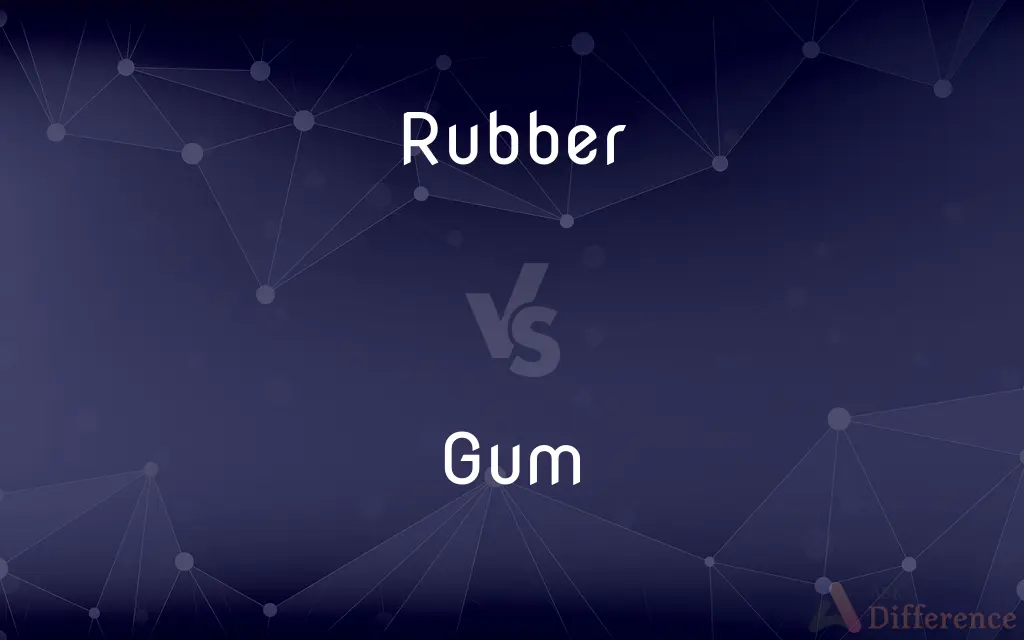Rubber vs. Gum — What's the Difference?
Edited by Tayyaba Rehman — By Urooj Arif — Updated on April 1, 2024
Rubber is a material known for its elasticity and strength, derived from latex, whereas gum refers to various substances, including natural tree exudates and chewable products.

Difference Between Rubber and Gum
Table of Contents
ADVERTISEMENT
Key Differences
Rubber, especially natural rubber, is harvested from the latex of rubber trees and then processed into a flexible, durable material used in a wide range of products from tires to gloves. Gum, in one context, refers to natural substances exuded by certain plants or trees, which can be chewed but not swallowed, and in another context, to various types of chewing gum, a popular confectionery made from synthetic materials.
Rubber's properties, such as its high elasticity and resistance to water and chemicals, make it ideal for industrial and automotive applications. On the other hand, natural gum's uses are more varied, ranging from food additives to adhesives, depending on its composition and the specific type of gum, like gum arabic or xanthan gum. Chewing gum, designed for oral consumption, is prized for its flavor and texture, offering no significant utilitarian value beyond enjoyment and potential dental benefits.
The production of rubber involves coagulation of the latex, followed by processes such as vulcanization, which enhances its durability and elasticity. Gum extraction, however, depends on the source; for example, chicle, used in natural chewing gum, is collected from the sap of the sapodilla tree. The production of synthetic chewing gums involves combining rubber-like substances with sweeteners and flavorings.
Environmental impact differentiates them further: rubber production, particularly synthetic rubber, has significant environmental effects, including pollution from factories. Natural gums, like gum arabic, are more sustainable, with their harvesting having minimal impact on the environment. The production and disposal of chewing gum, especially, pose environmental challenges due to its non-biodegradable nature.
Despite these differences, both rubber and gum share a commonality in their origin—both are initially derived from plant sources. However, their paths diverge significantly in processing, application, and environmental implications, reflecting their unique properties and the diverse needs they meet in society.
ADVERTISEMENT
Comparison Chart
Source
Derived from the latex of rubber trees or synthesized chemically.
Natural gums come from tree exudates; chewing gums are made from synthetic materials.
Uses
Industrial and automotive products, waterproof items, elastic bands.
Food additives, adhesives, chewing gum for oral consumption.
Properties
High elasticity, durability, resistance to water and chemicals.
Viscosity, adhesiveness, variable texture and flavor in chewing gums.
Production Process
Involves coagulation, vulcanization for natural rubber; synthetic rubber is chemically produced.
Collected from plants or synthetically produced; chewing gum combines synthetic rubber with sweeteners and flavors.
Environmental Impact
Synthetic rubber production is pollutive; natural rubber affects land use.
Sustainable harvesting for natural gums; chewing gum disposal poses environmental challenges.
Compare with Definitions
Rubber
Synthetic materials with properties similar to natural rubber.
Synthetic rubber is used extensively in tire manufacturing.
Gum
A substance exuded by some trees and plants.
Gum arabic is used as a stabilizer in food.
Rubber
A highly elastic material obtained from the latex of rubber trees.
The rubber boots kept her feet dry in the rain.
Gum
Chewing gum, a flavored product intended for chewing.
She enjoys chewing gum while studying.
Rubber
A material used in making flexible seals and gaskets.
The rubber gasket ensures a tight seal.
Gum
An adhesive substance.
The envelope flap was sealed with gum.
Rubber
Used for making erasers due to its ability to remove pencil marks.
He used a rubber to correct the mistake in his drawing.
Gum
A term for various thick liquid substances.
The machine was clogged with a sticky gum.
Rubber
An insulating material in electrical wiring.
The rubber coating on the wires prevents electrical shocks.
Gum
Natural or synthetic substances used in manufacturing sweets and adhesives.
Xanthan gum is used to thicken sauces and dressings.
Rubber
A tough elastic polymeric substance made from the latex of a tropical plant or synthetically
A rubber plantation
A rubber dinghy
Heat and sunlight may cause rubber to deteriorate
Gum
Any of various viscous substances that are exuded by certain plants and trees and dry into water-soluble, noncrystalline, brittle solids.
Rubber
A piece of rubber used for erasing pencil or ink marks
A pencil with a rubber at the end
Gum
A similar plant exudate, such as a resin.
Rubber
Rubber boots; galoshes.
Gum
Any of various adhesives made from such exudates or other sticky substance.
Rubber
A condom.
Gum
A substance resembling the viscous substance exuded by certain plants, as in stickiness.
Rubber
A contest consisting of a series of successive matches (typically three or five) between the same sides or people in cricket, tennis, and other games
The opening rubber of Britain's Davis Cup tie against Argentina
Gum
Any of various trees, especially of the genera Eucalyptus and Liquidambar, that are sources of gum. Also called gum tree.
Rubber
A yellowish, amorphous, elastic material, composed almost entirely of an isoprene polymer, obtained from the milky sap or latex of various tropical plants, especially the rubber tree, and vulcanized, pigmented, finished, and modified into products such as electric insulation, elastic bands and belts, tires, and containers. Also called caoutchouc, India rubber.
Gum
The wood of such a tree; gumwood.
Rubber
Any of numerous synthetic elastic materials of varying chemical composition with properties similar to those of natural rubber; an elastomer.
Gum
Chewing gum.
Rubber
A low overshoe made of rubber.
Gum
The firm connective tissue covered by mucous membrane that envelops the alveolar arches of the jaw and surrounds the bases of the teeth. Also called gingiva.
Rubber
(Baseball) The rectangular piece of hard rubber that the pitcher must remain in contact with when making a pitch.
Gum
To cover, smear, seal, fill, or fix in place with gum.
Rubber
An eraser.
Gum
To exude or form gum.
Rubber
A tire.
Gum
To become sticky or clogged.
Rubber
A set of tires on a vehicle.
Gum
To chew (food) with toothless gums.
Rubber
(Slang) A condom.
Gum
The flesh around the teeth.
Rubber
One that rubs, especially one that gives a massage.
Gum
Any of various viscous or sticky substances that are exuded by certain plants.
Rubber
A series of games of which two out of three or three out of five must be won to terminate the play.
Gum
Any viscous or sticky substance resembling those that are exuded by certain plants.
Rubber
An odd game played to break a tie.
Gum
Chewing gum.
Rubber
(uncountable) Pliable material derived from the sap of the rubber tree; a hydrocarbon polymer of isoprene.
Gum
(countable) A single piece of chewing gum.
Do you have a gum to spare?
Rubber
Synthetic materials with the same properties as natural rubber.
Gum
A gummi candy.
Rubber
An eraser.
Gum
A hive made of a section of a hollow gum tree; hence, any roughly made hive.
Rubber
A condom.
Gum
A vessel or bin made from a hollow log.
Rubber
(countable) Someone or something which rubs.
Gum
A rubber overshoe.
Rubber
One who rubs down horses.
Gum
A gum tree.
Rubber
One who practises massage.
Gum
To chew, especially of a toothless person or animal.
Rubber
A coarse towel for rubbing the body.
Gum
(transitive) To deepen and enlarge the spaces between the teeth of (a worn saw), as with a gummer.
Rubber
An abrasive for rubbing with: a whetstone, file, or emery cloth, etc.
Gum
To apply an adhesive or gum to; to make sticky by applying a sticky substance to.
Rubber
(historical) The cushion of an electric machine.
Gum
To stiffen with glue or gum.
Rubber
The rectangular pad on the pitcher's mound from which the pitcher must pitch.
Jones toes the rubber and then fires to the plate.
Gum
To inelegantly attach into a sequence.
Rubber
Water-resistant shoe covers, galoshes, overshoes.
Johnny, don't forget your rubbers today.
Gum
To impair the functioning of a thing or process.
That cheap oil will gum up the engine valves.
The new editor can gum up your article with too many commas.
Rubber
Tires, particularly racing tires.
Jones enters the pits to get new rubber.
Gum
The dense tissues which invest the teeth, and cover the adjacent parts of the jaws.
Rubber
A hardship or misfortune.
Gum
A vegetable secretion of many trees or plants that hardens when it exudes, but is soluble in water; as, gum arabic; gum tragacanth; the gum of the cherry tree. Also, with less propriety, exudations that are not soluble in water; as, gum copal and gum sandarac, which are really resins.
Rubber
(sports) In relation to a series of games or matches between two competitors where the overall winner of the series is the competitor which wins a majority of the individual games or matches:
Gum
See Gum tree, below.
Rubber
The entire series, of an odd number of games or matches in which ties are impossible (especially a series of three games in bridge or whist).
Gum
A hive made of a section of a hollow gum tree; hence, any roughly made hive; also, a vessel or bin made of a hollow log.
Rubber
An individual match within the series (especially in racquet sports).
Gum
A rubber overshoe.
Rubber
A rubber match; a game or match played to break a tie.
Gum
To deepen and enlarge the spaces between the teeth of (a worn saw). See Gummer.
Rubber
The game of rubber bridge.
Gum
To smear with gum; to close with gum; to unite or stiffen by gum or a gumlike substance; to make sticky with a gumlike substance.
He frets like a gummed velvet.
Rubber
Not covered by funds on account.
Gum
To chew with the gums, rather than with the teeth.
Rubber
(telephony) To eavesdrop on a telephone call
Gum
To exude or form gum; to become gummy.
Rubber
(slang) To rubberneck; to observe with unseemly curiosity.
Gum
A preparation (usually made of sweetened chicle) for chewing
Rubber
One who, or that which, rubs.
Gum
The tissue (covered by mucous membrane) of the jaws that surrounds the bases of the teeth
Rubber
In some games, as bridge or whist, the odd game, as the third or the fifth, which decides the winner when there is a tie between the players; as, to play the rubber; also, a contest determined by the winning of two out of three games; as, to play a rubber of whist.
Gum
Any of various substances (soluble in water) that exude from certain plants; they are gelatinous when moist but harden on drying
Rubber
India rubber; caoutchouc; gum elastic; - also called natural rubber.
Gum
Cement consisting of a sticky substance that is used as an adhesive
Rubber
Any substance, whether natural or synthetic, resembling India rubber with respect to its elasticity[1].
Gum
Wood or lumber from any of various gum trees especially the sweet gum
Rubber
A low-cut overshoe made of natural or synthetic rubber[4], serving to keep the feet and shoes dry when walking in the rain or on a wet surface; - usually used in the plural.
Gum
Any of various trees of the genera Eucalyptus or Liquidambar or Nyssa that are sources of gum
Rubber
A condom.
Gum
Grind with the gums; chew without teeth and with great difficulty;
The old man had no teeth left and mumbled his food
Rubber
Latex from trees (especially trees of the genera Hevea and Ficus)
Gum
Exude or form gum;
These trees gum in the Spring
Rubber
An eraser made of rubber (or of a synthetic material with properties similar to rubber); commonly mounted at one end of a pencil
Rubber
Contraceptive device consisting of a thin rubber or latex sheath worn over the penis during intercourse
Rubber
A waterproof overshoe that protects shoes from water or snow
Rubber
Coat or impregnate with rubber;
Rubberize fabric for rain coats
Rubber
Made of rubber and therefore water-repellent;
Rubber boots
Rubber
Returned for lack of funds;
A rubber check
A no-good check
Common Curiosities
What are the main uses of gum arabic?
Gum arabic is used as a stabilizer, emulsifier, and thickening agent in the food industry, as well as in pharmaceuticals and cosmetics.
Can rubber be environmentally friendly?
Natural rubber can be produced sustainably, but synthetic rubber manufacturing has significant environmental impacts.
Are all gums biodegradable?
Natural gums are biodegradable, but most commercial chewing gums contain synthetic bases that are not easily biodegradable.
How is natural rubber obtained?
Natural rubber is obtained by tapping the bark of rubber trees to collect the latex, which is then processed.
What makes chewing gum chewable?
Chewing gum is made from synthetic rubber-like substances combined with sweeteners and flavors, giving it its chewable texture.
What are gums?
Gums can refer to natural substances exuded by trees, used in food and adhesives, or to chewing gum, a synthetic confectionery.
How does the elasticity of rubber benefit industrial applications?
Rubber's elasticity makes it ideal for products requiring flexibility and shock absorption, such as tires and gaskets.
What is rubber?
Rubber is a material known for its elasticity, derived either from the latex of rubber trees or synthesized chemically.
How is rubber used in automotive applications?
Rubber is used in tires, seals, hoses, and belts due to its durability and elasticity.
What distinguishes synthetic rubber from natural rubber?
Synthetic rubber is chemically produced and can be tailored for specific properties, whereas natural rubber is derived from latex and has a fixed set of natural properties.
Is chewing gum harmful to the environment?
Yes, because it is non-biodegradable and its improper disposal can lead to environmental pollution.
Can gum be used in medical applications?
Yes, certain natural gums are used in pharmaceuticals as binders, emulsifiers, or for encapsulation.
What are the environmental concerns associated with rubber production?
Deforestation for rubber plantations and pollution from synthetic rubber production are major concerns.
What role does gum play in the food industry?
Gums are used as thickeners, stabilizers, and emulsifiers in various food products.
How are synthetic gums created?
Synthetic gums are created by chemically synthesizing rubber-like materials and adding sweeteners and flavors for chewing gum, or by modifying natural substances for industrial gums.
Share Your Discovery

Previous Comparison
Foundation vs. Plinth
Next Comparison
Shot vs. ShootedAuthor Spotlight
Written by
Urooj ArifUrooj is a skilled content writer at Ask Difference, known for her exceptional ability to simplify complex topics into engaging and informative content. With a passion for research and a flair for clear, concise writing, she consistently delivers articles that resonate with our diverse audience.
Edited by
Tayyaba RehmanTayyaba Rehman is a distinguished writer, currently serving as a primary contributor to askdifference.com. As a researcher in semantics and etymology, Tayyaba's passion for the complexity of languages and their distinctions has found a perfect home on the platform. Tayyaba delves into the intricacies of language, distinguishing between commonly confused words and phrases, thereby providing clarity for readers worldwide.














































